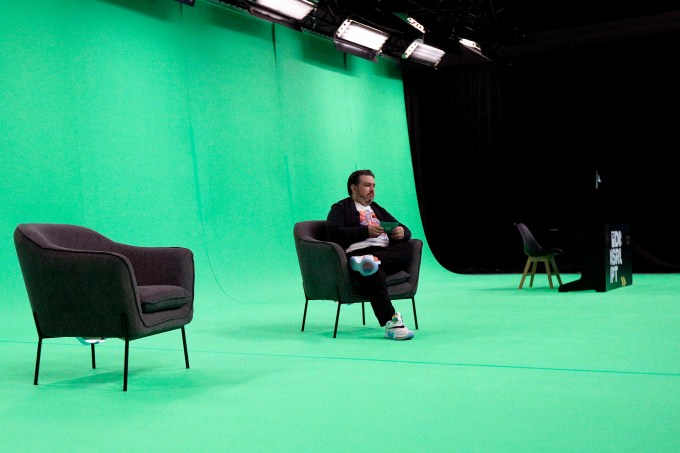World News
10 years at TechCrunch on August 28, 2023 at 3:06 pm

It’s been 10 years since I stepped off a ledge and landed at TechCrunch.
I don’t get self referential a lot here on the pages of TC, but I figured that a tin anniversary is a nice time to look at what we’ve done over the past decade as we approach this year’s Disrupt, coming up on September 19th-21st in San Francisco.
Like many people who have joined our team over the years, when I came on board, I landed right into the middle of the TechCrunch Disrupt conference – the proverbial fire. All hands on deck, circulating the tables, scooping news, preparing for their interviews, handling the logistics of a huge event with split second decisions and changing conditions every minute. With everyone offering help to each other where needed.
I never forgot that intense “team first” vibe and have tried to carry it forward with us.
Since 2013, nearly 3 billion visitors have read what TechCrunch has to say about the world of startups. It’s been amazing to spend a decade at the startup ecosystem publisher of record, and it’s never been boring.
There are too many stories over the past decade to mention them all, but there have been some bangers. The intense examinations of how burrowing owls connect to the SF housing crisis, scooping the death of Google+, defining the Unicorn, blockbuster investigations into spyware tools, disclosing Facebook playing fast and loose with Apple rules and the resulting deactivation of its own internal apps, Apple re-launching Maps and apologizing for the Mac Pro (when I published a rare full transcript of an Apple executive interview – that was a fun call), the story of when two hackers saved the Internet, plenty of acquisition scoops, crazy early coverage of future giants like Robinhood, when we accidentally deactivated when we traveled halfway around the world to be the first to find the man who deactivated Trump’s Twitter account, and in a very TechCrunch move, plenty of coverage of…TechCrunch.
Throughout this period we’ve endured a long list of owners above us who never really ‘got’ what TechCrunch was about. Thankfully, Yahoo’s current leadership does get it, the CEO even launched his company on our stage 13 years ago.
But in the past, we definitely had to deal with a lot of very aggressive ‘suggestions’ that it took a lot of energy and time to deflect. But it was worth it.
I still remember a conversation with leadership in early 2014 where co-editor Alexia Tsostsis and I were basically told that TechCrunch wasn’t a growth property. And, to quote the goat, we took that personally.
Even though we’ve remained a lean team, typically under 60 people total across our business and editorial teams over most of that period, it didn’t stop us.
In fact, it has allowed TechCrunch to remain a permissionless state that has shipped and shipped and shipped without waiting for people or resources.
And we still grew, and are continuing to do so. In spite of everything.
During the past 10 years at TechCrunch we have done, well, a lot.
We doubled the size of TechCrunch Disrupt, without killing its special vibe.
Radically improved the inclusion and audience makeup of the TC team and Disrupt as a show.
Delivered a full-size Disrupt show virtually, pivoting hard in the early days of the pandemic.
Publish an average of 30-50 stories every day about existing companies and emerging technology in a human, genuine voice that prioritizes skepticism, not cynicism.
Created our successful subscription product TechCrunch+ that offers a deeper look into the hows of startups for builders.
Publish the killer Equity, Found, Chain Reaction and TechCrunch Live podcasts.
Increased Startup Battlefield’s cohort size to 200.
Launched hugely successful newsletters with industry-leading open rates.
Introduced hundreds of companies on the Startup Battlefield stage.
Shipped several major site redesigns.
Delivered incredible video content that goes deep on early stage tech.
How was TechCrunch able to keep shipping new experiments, successful products and high quality news without major investment for a decade?
I’m going to give you the secret sauce, right now:
We have hired and fostered extremely talented people and then…we trust them.
That’s it.
TechCrunch was already a special place to work when I joined, and we have tried to make sure we never lost its particular blend of anarchy and authority, anchored by a generous spirit.
When people care about one another and that attitude is transmitted from the top, they will deliver outsized efforts on undersized resources for the love of the game and of each other. To support that, my senior staff and I always made an effort to make sure that the job wasn’t about us, it was about them, which made them want to be about TechCrunch.
This willingness to help each other has allowed us to punch above our weight forever, beating publications with hundreds or thousands of journalists to stories and trends every single day.
The TechCrunch Way.
To the consternation of PR departments everywhere, TechCrunch is managed significantly differently than other editorial organizations. Writers assign most of their stories to themselves, and bring editors in later. They generally work in areas of obsession, not beats. The most compelling stories about technology are told by those who are willing to drill all the way down to the whitepaper to understand it.
Whatever point or angle you have about a technology, especially the most important and fundamentally world altering ones, it has to begin at a place of understanding. Otherwise you’re building on sand and standing up straw men.
Most of our writers also have direct access to the publish button and generally write their own headlines, deks and ledes. You know, that trust thing.
Why would we hire people who were genuinely obsessed with a given technology or space and then not use their most potent asset: their sense of taste.
These days, you could argue that taste is the only moat. And when you apply that to everything from story sense to sourcing, you get a product that remains vital.
It’s hubris to think that any editor has an infinitely variable mouthfeel sensor that can pick up on everything brewing in the enormously diverse universe of technology enabled companies, from startup to IPO and beyond. The people I’ve had the luck and pleasure to work with at TechCrunch past and present have been the most incredible truffle hunters of scoops, true stories and new things I’ve ever seen.
All of the current staff and many, many others over the years are what have made TechCrunch such a special place to work. You only have to look at how many people leave and come back to work here 2, 3 or even 4 times to see that there’s a thing about this place.
Image Credits: Slava Blazer / Flickr (opens in a new window) under a CC BY 2.0 (opens in a new window) license.
TechCrunch is about founders.
A few thousand people gathered in San Francisco at the Design Concourse for TechCrunch Disrupt the year that I joined. Last year, despite the trailing effects of COVID, 10,000 people showed up. Our audience has always been mapped to the ebbs and flows of the ecosystem, so that’s encouraging.
Being the editorial programming buck stop for Disrupt is an enormous undertaking every year – especially as we used to run 3 per year. But it’s also energizing.
We’ve tried to make our annual event a global affair, with a far more diverse group of participants. This year’s Disrupt conference houses specialized programming across AI, security, SaaS, sustainability, fintech and hardware sectors. It also has a dedicated Builder track that gets into the nitty gritty of running and growing young companies. This year’s Disrupt will have nearly 50% women participating and 40% of the overall program participants come from backgrounds that are underrepresented in startups.
Another highlight is our Startup Battlefield program. Every year, we get thousands of applications to be a part of the competition. After Head of Startup Battlefield Neesha Tambe and her team filter these applications, we get together and hammer out the top 20 in weeks of two-a-days.
Then, they go into a training program to get them ready for the stage and present their company in front of incredible judges. The judging process gives a rare public look at the decision making process of high level entrepreneurs and investors. And into the ways that founders can successfully pitch their products. It’s as intense as any startup accelerator and just as fun to see the shape of what’s to come.
Because the companies apply to us so early, often in pre-funding or bootstrapped stages, we have gotten to get a yearly early look at the future. And that’s why all of us at TechCrunch do what we do – we live in the future, and we love it.
It was a big moment last year when we were able to expand the program to the Startup Battlefield 200. This effectively ended our practice of charging startups to buy a table at Disrupt, making exhibiting at the show completely free for the 200 companies chosen to be a part of Battlefield.
Over the course of the program we’ve featured over 1,300 startups, who have raised $29B in capital and have had 200 exits. The Startup Battlefield alumni represent a whole generation’s worth of entrepreneurs and is inclusive of gender, race, geography and vertical.
It has taken a lot of dedication and attention to detail to get it to the great place it’s in now, and we’re just getting started.
Sugar Rush
When a grape vine is stressed, it puts all of its resources into the production of sugary, flavorful grapes. Any wine maker knows that a stressing season for vines means an incredible vintage is just a couple of years away from the bottle.
Many startup companies will only survive the next couple of years by being more inventive and crisp with their fundamentals. They’re going to have to survive on less and be more focused on self-sufficiency. But we’ve been seeing some very interesting shifts here. Founders are more focused on fundamentals, for one. Startup Battlefield applications have been far more likely to mention early revenue and traction, even in seed or pre-seed companies. The go-to-market slides are getting more defined and more focused on extending working capital runways. The founding teams are more likely to include someone with a background in revenue and growth even at earlier stages.
The founders themselves are also just incredibly impressive. They’re coming into this game well aware of the current stakes and with all of the context that has come before. They’re ready.
The Stressed Grape Startups are coming, and they’re going to be more resilient and richer with experience for it.
This has been an amazing decade to cover and participate in one of the most fascinating communities in the world. The eternal joy, optimism and cleverness of founders, designers, developers and hustlers is infectious and I never want to stop being close to that energy. There’s some kind of mania that infuses entrepreneurs – those folks who just can’t help but step off of ledges and into the thin air of hope.
I’m massively optimistic about the coming wave of founders and companies. Though the funding environment is tough right now, you can see the explosion coming.
This one goes out to the ledge steppers. We’ll see you at Disrupt!
It’s been 10 years since I stepped off a ledge and landed at TechCrunch. I don’t get self referential a lot here on the pages of TC, but I figured that a tin anniversary is a nice time to look at what we’ve done over the past decade as we approach this year’s Disrupt, coming
Politics
Netanyahu’s UN Speech Triggers Diplomatic Walkouts and Mass Protests

What Happened at the United Nations
On Friday, Israeli Prime Minister Benjamin Netanyahu addressed the United Nations General Assembly in New York City, defending Israel’s ongoing military operations in Gaza. As he spoke, more than 100 delegates from over 50 countries stood up and left the chamber—a rare and significant diplomatic walkout. Outside the UN, thousands of protesters gathered to voice opposition to Netanyahu’s policies and call for accountability, including some who labeled him a war criminal. The protest included activists from Palestinian and Jewish groups, along with international allies.

Why Did Delegates and Protesters Walk Out?
The walkouts and protests were a response to Israel’s continued offensive in Gaza, which has resulted in widespread destruction and a significant humanitarian crisis. Many countries and individuals have accused Israel of excessive use of force, and some international prosecutors have suggested Netanyahu should face investigation by the International Criminal Court for war crimes, including claims that starvation was used as a weapon against civilians. At the same time, a record number of nations—over 150—recently recognized the State of Palestine, leaving the United States as the only permanent UN Security Council member not to join them.
International Reaction and Significance
The diplomatic walkouts and street protests demonstrate increasing global concern over the situation in Gaza and growing support for Palestinian statehood. Several world leaders, including Colombia’s President Gustavo Petro, showed visible solidarity with protesters. Petro called for international intervention and, controversially, for US troops not to follow orders he viewed as supporting ongoing conflict. The US later revoked Petro’s visa over his role in the protests, which he argued was evidence of a declining respect for international law.

Why Is This News Important?
The Gaza conflict is one of the world’s most contentious and closely-watched issues. It has drawn strong feelings and differing opinions from governments, activists, and ordinary people worldwide. The United Nations, as an international organization focused on peace and human rights, is a key arena for these debates. The events surrounding Netanyahu’s speech show that many nations and voices are urging new action—from recognition of Palestinian rights to calls for sanctions against Israel—while discussion and disagreement over the best path forward continue.
This episode at the UN highlights how international diplomacy, public protests, and official policy are all intersecting in real time as the search for solutions to the Israeli-Palestinian conflict remains urgent and unresolved.
News
Is a Nuclear-Powered Alien Spacecraft Flying Toward Earth?

A mysterious interstellar object speeding through our solar system has reignited debates about extraterrestrial technology — and whether Earth might currently be under quiet observation.
The object, known as 3I/ATLAS, is only the third confirmed interstellar visitor ever detected. Unlike ordinary comets, however, this cosmic traveler has baffled astronomers with its unusual brightness, strange trajectory, and lack of a visible cometary tail. While most scientists cautiously describe it as a natural body, one leading astrophysicist believes something much stranger is at play.

Harvard Scientist’s Bold Claim
Professor Avi Loeb of Harvard University, head of the Galileo Project, has suggested that 3I/ATLAS may in fact be a nuclear-powered alien spacecraft designed to test how humanity would respond to an interstellar visitor. He argues that its flight path is improbably precise, bringing it close to Mars, Venus, and Earth — a pattern highly unlikely to occur by chance.
Loeb also points out that telescope images show a glow inconsistent with ordinary dust behavior. Instead of trailing behind like a comet, the halo-like light appears to extend in unusual ways, sparking debate about whether the object could be emitting energy of its own.
Headed Toward Earth’s Neighborhood
3I/ATLAS is expected to make its closest approach in late 2025, passing near Mars before swinging by the inner solar system. Although Earth itself will be on the opposite side of the Sun when it comes closest, the alignment will still enable space-based observatories to capture sharper data.

Loeb has called on NASA and other agencies to use spacecraft already stationed near Mars or Jupiter — including the Juno mission — to take high-resolution photographs. He believes such efforts could reveal whether the interstellar object is truly natural, or the first technological probe humanity has ever encountered.
Should We Be Worried?
While most astronomers argue caution before jumping to alien conclusions, Loeb insists that scientific openness is key. “If it’s just a comet, we learn something new,” he said. “But if it’s a spacecraft, it would be the most important discovery in human history.”
For now, 3I/ATLAS remains a mysterious speck on astronomers’ charts, drifting closer with each passing day. Whether it proves to be a frozen remnant of another star system or something far more advanced, the interstellar visitor has already succeeded in one mission: reminding us how vast and unpredictable the universe really is.
News
AI Automation Could Cause Up to 20% Unemployment—A Workforce on the Brink

Stark Warning from Anthropic CEO Highlights Rapid Job Displacement Risk
The looming threat of widespread unemployment due to AI automation has sparked intense debate among experts, business leaders, and policymakers. Dario Amodei, CEO of Anthropic—the company behind the influential AI language model Claude—issued a stark warning that has sent shockwaves through corporate America:

“Up to half of all entry-level white collar jobs could disappear within the next one to five years, potentially pushing unemployment rates as high as 20% during this period.”
This dramatic forecast paints a picture of a rapid and unsettling transformation in the workforce, driven by AI technologies that can perform complex cognitive tasks.
Balancing Predictions: Worst-Case Scenarios vs. Moderate Impact
However, this forecast represents one end of a spectrum of expert predictions. While Amodei’s warning highlights the worst-case scenario driven by the swift adoption of AI agents capable of coding, analyzing data, drafting legal documents, and managing workflows around the clock, other analyses suggest a more moderate impact. For example, Goldman Sachs estimates that AI could temporarily displace about 6-7% of U.S. jobs, with unemployment rising by approximately half a percentage point during the adjustment period. Their research anticipates a more gradual transition with a mixture of job disruption and creation.

The Unprecedented Speed and Scope of AI-Driven Job Disruption
The truth likely lies somewhere in between. AI is advancing at unprecedented speed, and the scope of jobs affected spans far beyond blue-collar roles to white-collar positions that required college degrees and years of training. Entry-level roles such as customer service representatives, data entry clerks, junior analysts, and administrative assistants face the greatest near-term risk. Mid-level roles in accounting, marketing, law, and engineering could soon follow, with companies already laying off workers citing AI-driven efficiencies.
Preparing for an AI-Transformed Workforce: Adaptation Is Essential
Ultimately, the AI-driven job transformation is no longer a distant prospect but unfolding now. Whether unemployment spikes to 20% or stabilizes at lower levels depends on many factors, including business adoption rates, government policies, and the ability of workers to reskill. What is certain is that the workforce of tomorrow will look very different from today—and the time to prepare is right now.

 Entertainment4 weeks ago
Entertainment4 weeks agoExecutive Producer Debut: How Celia Carver Created Festival Hit ‘Afterparty’

 Business3 weeks ago
Business3 weeks agoWhy Are Influencers Getting $7K to Post About Israel?

 Health4 weeks ago
Health4 weeks agoWhy Did Gen Z QUIT Drinking Alcohol?

 Advice4 weeks ago
Advice4 weeks agoHow AI Is Forcing Everyone Into the Entrepreneur Game

 Entertainment3 weeks ago
Entertainment3 weeks agoKeith Urban and Nicole Kidman Split After 20 Years as Actress Files for Divorce

 Entertainment3 weeks ago
Entertainment3 weeks agoTilly Norwood’s Rise Stirs Controversy

 News3 weeks ago
News3 weeks agoHow a Government Shutdown Could Hit Your Life and Wallet

 Entertainment3 weeks ago
Entertainment3 weeks agoWhy Did Dakarai Trash His NBA Letters?






























